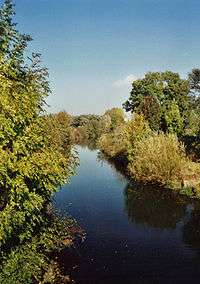Innerste
| Innerste | |
|---|---|
 The Innerste in Sarstedt. | |
| Country | Germany |
| Basin | |
| Main source |
Harz 615 m (2,018 ft) |
| River mouth |
Leine 52°14′50″N 9°49′30″E / 52.24722°N 9.82500°ECoordinates: 52°14′50″N 9°49′30″E / 52.24722°N 9.82500°E |
| Basin size | 1,300 km2 (500 sq mi) |
| Physical characteristics | |
| Length | 95 km (59 mi) |
| Discharge |
|
The Innerste is a river in Lower Saxony, Germany. It is a right tributary of the Leine river and 95 km in length.


Origin of the name
The name Innerste, in earlier times called the Inste (1805), Inderste (1567), Indistria (1313), Entrista (1065) and Indrista (1013), probably goes back to the Indo-Germanic root oid = turbulent, strong. It may be the name referred to in the name of the battlefield of Idistaviso (16 A.D.). It is therefore not a superlative and is declined without a case ending in German e.g.: Hildesheim liegt an der Innerste, not: an der Innersten.
Course
The river's source is in the Harz mountains, 4 km from the town of Clausthal-Zellerfeld to the southwest at an elevation of 615 m and is called Innerstesprung. As a small brook, the Innerste flows west and passes a system of lakes, the first of which is called Entensumpf. The next lakes are Oberer Nassenwieser Teich, Bärenbrucher Teich, Ziegenberger Teich, and Sumpfteich. The German word Teich means "pond".
Having passed through the middle of the village of Buntenbock, the Innerste passes Prinzenteich and turns to the west to Wildemann (390 m), one of the smallest towns in Germany. Grumbach, one of the first tributaries, flows into the Innerste in the middle of Wildemann. The Innerste turns to the North to Lautenthal (300 m), another town on its course and flows parallel to the abandoned track of the Innerste Valley Railway. Here the Laute flows into the Innerste in the middle of Lautenthal. The name of the town means "Laute Valley". Near Lautenthal the Innerste is dammed (the Innerstetalsperre). When the dam was built 1963-1966, a nice lake for holidays and watersports was created. A few kilometers further on, the Innerste leaves the Harz Mountains near the town of Langelsheim (204 m) and turns to the Northwest. The first tributary is river Grane (12 km in length).
From here, the Innerste flows through the Harzvorland, a hilly countryside. Further tributaries are river Nette (42 km in length), river Lamme (21 km in length), river Bruchgraben, river Neile and river Beuster (12 km in length). Some more towns on its course are the southern quarters of Salzgitter and Hildesheim. The Innerste passes Marienburg Castle, the centre of Hildesheim (90 m) and Steuerwald Castle in the North of the City.
North of Hildesheim, the Innerste enters the Norddeutsche Tiefebene, a large plain. About 18 km further on, it flows into the Leine near the town of Sarstedt, south of Hanover, at an elevation of 65 m.
Media
Wilhelm Raabe wrote a novelle titled Die Innerste.
Sources
- Sönke Martens, Erich Heinemann: Lebensader Innerste: von der Quelle bis zur Mündung. Gerstenberg, Hildesheim 1999, ISBN 3-8067-8543-0
- Heinrich Hofmeister: Naturraum Innerstetal. Mitteilungen der Paul-Feindt-Stiftung Band 4. Gerstenberg, Hildesheim 2003
- Bibliographisches Institut & F. A. Brockhaus AG, 2001, Brockhaus multimedia 2002
- Ludger Feldmann: Hildesheim im Eiszeitalter - eine Bilderreise. In: Manfred Boetzkes, Ingeborg Schweitzer, Jürgen Vespermann (Hrsg.): EisZeit. Das große Abenteuer der Naturbeherrschung. Begleitbuch zur gleichnamigen Ausstellung. Jan Thorbecke Verlag, Stuttgart 1999 und Roemer- und Pelizaeus-Museum Hildesheim 1999, Seite 95-106.